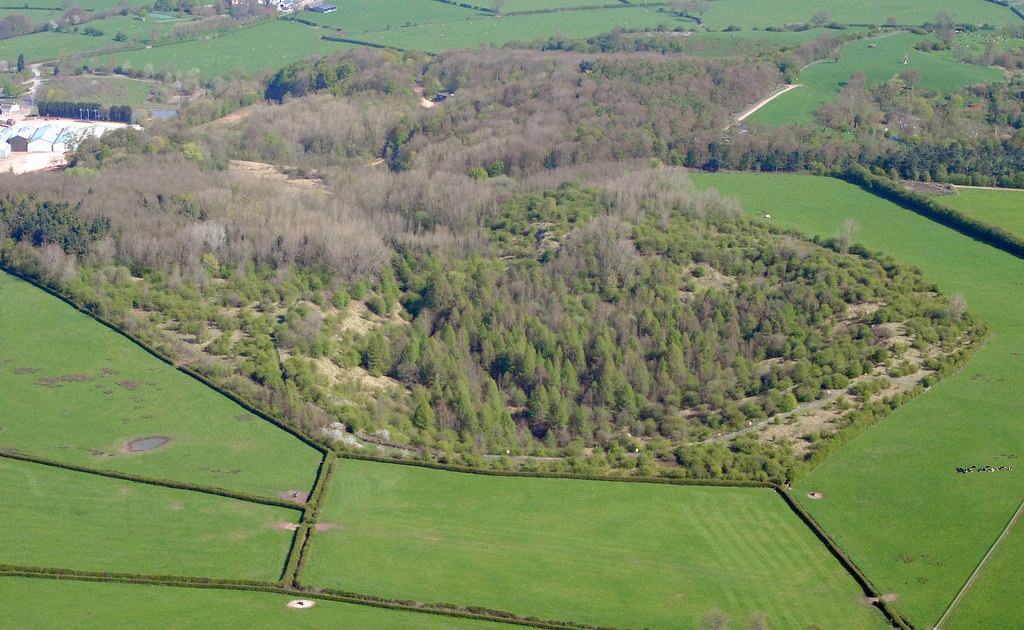On the outskirts of the small village of Hanbury, in Staffordshire, England, a few minutes walk from The Cock Inn, is a large crater created by one of the largest accidental explosions in history, which is also the largest non-nuclear explosion to occur on UK soil. The incident occurred at exactly eleven minutes past eleven on 27 November 1944.
In those day, the area was used by the Royal Air Force as an ammunition dump called RAF Fauld. The ammunitions were stored underground in disused gypsum mines, and contained, at the time of the explosion, nearly 4,000 tons of ordnance and 500 million rounds of rifle ammunition, and a variety of other weapons.
The Fauld Crater (also called Hanbury Crater) today. Photo credit: Barry Wright/Tutbury
For several months, the RAF was struggling with shortage of staff, forcing the management to appoint two hundred Italian POWs in various jobs around the camp. Many of them were commissioned to work at the munitions storage depot, where they handled live bombs and performed dangerous tasks that required sleight and experience. A simple mistake, such as choosing the wrong tool, can have fatal consequences. And that’s exactly what happened.
An enquiry after the accident revealed that one airmen was trying to remove the detonator from a live bomb, but instead of using a wooden batten he was using a brass chisel —producing a fatal spark. In one instant, the entire dump went up into the air in two gigantic mushroom clouds.
Everything within a kilometer of the mine was obliterated. Flying debris rained down on villages located 10 km away damaging houses and churches. The retaining walls of a nearby reservoir gave away and the resulting flood destroyed a plaster factory killing 37 workers within it. Altogether around 70 people lost their lives, and some 200 cattle perished. The explosion was heard and felt 60 km away, and recorded on seismographs all over Europe.
Whilst much of the storage facility was annihilated by the explosion, the site itself continued to be used by the RAF for munition storage until 1966, and there are still a significant amount of unexploded munitions buried below the crater.
The crater from the explosion is still 30 meters deep and 230 meter across, although it is now taken over by nature. The crater floor is covered by small shrubs and mature trees. A circular footpath along the rim was created to make the crater more accessible. Standing beside the rim is a memorial dedicated to those who died in the explosion.
Bombs being stacked in one of the tunnels at RAF Fauld. Photo credit: Daventry B J/Wikimedia
Photo credit: Daily Mail
Photo credit: Daily Mail
Photo credit: Daily Mail
Photo credit: Daily Mail
Photo credit: steve p2008/Flickr
Photo credit: David Farquhar/Flickr

Photo credit: Barry Wright/Tutbury
Photo credit: SK53 OSM/Flickr
Memorial to the victims at the National Memorial Arboretum. Photo credit: David Farquhar/Flickr
Sources: Wikipedia / BBC / East Midlands Geological Society























Brass cannot make a spark against steel. That is why brass tools are used when sparks may be dangerous. Your article has a glaring error!
ReplyDeleteIt can create an electrical spark though that jumps from metal to metal.
DeleteThat wasn't the cause. Where's the static for the electrical charge going to come form? Nylon wasn't much in use for clothing or anything else in 1944. It was a very new thing in 1939!
ReplyDeleteA lot of the bombs had the detonators in them not just one. There was/is a very sharp bend in the roller conveyor the boxes of bombs, with detonators, were sent down into the storage area. There is a possibility that one of the boxes came off the rails & one thing lead to the other. How do I know? I know someone who was there 2 weeks before the accident. He said the working practices there made him nervous & he used to work with bombs & used to wander about with bottles of mercury fulminate in his pockets. . . . . .
How could anyone possibly know what caused it since all the immediate observers were vaporized. Several things could have caused it not including unknown ones.
ReplyDelete